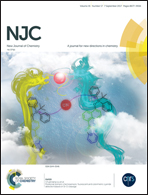Temperature dependent dielectric relaxation of ionic liquid ([bmim][BF4])/alcohol binary mixtures
Abstract
A dielectric spectroscopy study on the binary mixtures of the ionic liquid (IL) 1-butyl-3-methylimidazolium tetrafluoroborate ([bmim][BF4]) and four kinds of alcohols as a function of temperature was carried out over a frequency range of 100 MHz to 20 GHz. A wide-band dielectric relaxation was found at about 1 GHz. The relaxation contains the contributions of the IL and alcohols respectively due to the reorientation of the polar cation bmim+ and the cooperative dynamics of the alcohol molecules. The ion conduction ability of the IL in the four alcohols indicates that for IL/methanol and IL/ethanol systems, the interactions between solvents and the IL are stronger than those in IL/propanol (or isopropanol) systems, and the two components may not be uniformly mixed, which are also supported by the analysis of activation entropy. We also found that the isopropanol and propanol molecules have more influence on the rotation of the IL and cooperative motion of alcohols. From the temperature-dependent dielectric spectra, the thermodynamic parameters for the relaxation process such as activation energies, Gibbs free energy, enthalpy and entropy were obtained. It was found that the relaxation process observed in this work is driven by entropy.
![Graphical abstract: Temperature dependent dielectric relaxation of ionic liquid ([bmim][BF4])/alcohol binary mixtures](/en/Image/Get?imageInfo.ImageType=GA&imageInfo.ImageIdentifier.ManuscriptID=C7NJ01443K&imageInfo.ImageIdentifier.Year=2017)


 Please wait while we load your content...
Please wait while we load your content...